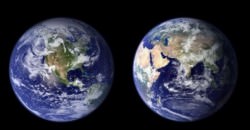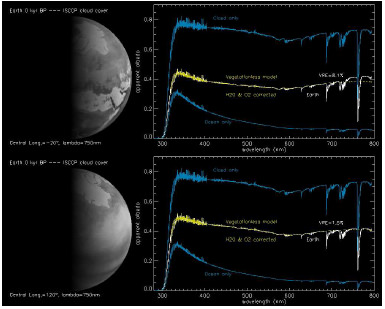[/caption]
What if another civilization had telescopes and spacecraft better than ours? Would Earth be detectable from another planet a few light-years away? Likewise, what will it take for us to detect life on an Earth-like planet within a similar distance? It’s interesting to consider those questions, and now, there is data to help answer them. In December 1990, when the Galileo spacecraft flew by Earth in its circuitous journey to Jupiter, scientists pointed some of the instruments at Earth just to see how the old home planet looked from space. Since we knew life could definitely be found on Earth, this exercise helped create some criteria that if found elsewhere, would point to the existence of life there as well. But what if Earth’s climate was different from what it is now? Would that signature still be detectable? And could potential biomarkers from extra solar planets holding climates much colder or warmer than ours be obvious? A group of researchers in France input some various criteria garnered from different epochs in Earth’s history to test out this hypothesis. What did they find?
One of the most telling of the criteria from the Galileo flyby revealing life on Earth was what is called the vegetation red edge –a sharp increase in the reflectance of light at a wavelength of around 700 nanometers. This is the result of chlorophyll absorbing visible light but reflecting near infrared strongly. The Galileo probe found strong for this evidence on Earth in 1990.
Luc Arnold and his team at the Saint-Michel-l’Observatoire in France wanted to determine some different parameters where plant life similar to Earth’s would still be detectable via the vegetative red edge on an Earth-like planet orbiting a star several light years away.

At that distance the planet would be a non-resolvable (in visible light) point-like dot, so the first question to consider is whether the red edge would be visible at different angles. The planet is likely to be rotating, and for example, on Earth, the continents that have the most vegetation are mainly in the northern hemisphere. If that hemisphere wasn’t leading the view, would a bio-signature still be detectable? They also wanted to allow for the different seasons, where a hemisphere in winter would be less likely to have vegetative biomarkers than one in summer, and potential heavy cloud cover.
They also input different climate criteria from the last Quaternary climate extremes, using climate simulations have been made by general circulation models. They used data from the present time and compared that to an ice age, The Last Glacial Maximum (LGM) which occurred about 21,000 years ago. Temperatures globally were on the order of 4 degrees C colder than today, and ice sheets covered most of the northern hemisphere. Then, they used a warmer time, during the Holocene epoch 6,000 years ago, when the Earth’s northern hemisphere was about 0.5 degrees C warmer than today. The sea level was rising and the Sahara Desert contained more vegetation.
Surprisingly, the researchers found even during winter in an ice age, the vegetation red signal would not be significantly reduced, compared to today’s climate and even the warmer climate.
So if another Earth is out there, the vegetaion red edge should allow us to find that Earth-like planet. But we need better telescopes and spacecraft to find it.
The best hope on the horizon is the Terrestrial Planet Finder. ESA has a similar instrument in the works called Darwin.
The teams behind these instruments say they could spot Earth-like planets orbiting stars at distances of up to 30 light years with an exposure measured in a couple of hours.
Arnold’s team says that spotting the signs of life on such a planet would be much harder. The vegetation red edge might only be seen with an exposure of 18 weeks with a telescope like the Terrestrial Planet Finder’s. An 18 week exposure of a planet orbiting another star would be an almost impossible task.
So when might we eventually see vegetation on another planet? The Terrestrial Planet Finder (TPF) looks unlikely to be launched before 2025 and even then might not have the power to do the job.
More ambitious telescopes later in the century, such as a formation of 150 3-meter mirrors would collect enough photons in 30 minutes to freeze the rotation of the planet and produce an image with at least 300 pixels of resolution, and up to thousands depending on array geometry. “At this level of spatial resolution, it will be possible to identify clouds, oceans and continents, either barren or perhaps (hopefully) conquered by vegetation,” the researchers write.
Sources: arXiv, arXiv blog


Aaarrrggghhhh!!!! I hate waiting for new awesome telescopes to be made. Being 30 years old I would so love to see continents on an extra solar planet (assuming life goes smoothly for me) before Im dead. Perhaps this is a field I should look into becoming an engineer for.
Where did the photo of (I assume) Earth and the spectograms come from? I want to see full sized. What is the Y axis of the spectrograms? X axis is wavelength, what is y?
An 18 week exposure is difficult but I don’t think it’s impossible. MOST can take 8.5 week exposures
I hope that we’ll soon see a project similar to SETI@home or other BOINC projects that would link thousands of amateur telescopes into an array, allowing so for hi-resolution observations by amateurs. The number and the quality woud probably not reach those of an array of 150 3m telescopes, but I bet some exciting research could be done anyway.
Some of the civilizations seen on Star Trek were rather unfriendly and contact with such “people” would be a bad idea.
That’s fictional but some are quite possible. Perhaps a bit of caution is called for.
Dan, think about it. This article explains exactly why it’s pointless to worry about alerting aliens on other planets as to our existence.
If they have telescopes large enough and powerful enough, they can see us already! (Well, they can see that there is life on Earth and they can see that there is a technological civilization on Earth too — chemical pollutants and light emissions from the night-side.
We will almost certainly have telescopes big enough to detect these things from light-years away within a century or two, so imagine what an alien civilization with, say, a 5,000 year lead on us in terms of technology. (5,000 years is nothing in galactic historical terms). We have absolutely no hope of hiding our presence from any such advanced civilizations — if they’re out there, and if they are close enough (within a few hundred light years) then they’ve already spotted Earth, and quite likely already know a great deal about the planet we call home.
Nice piece, but :
“The Galileo probe found strong for this evidence in Earth 1990”
A little re-editing needed, maybe?
Tacitus,
I do agree completely its pointless to hide our emissions.
If another species in our “stellar neighborhood” has seen our little neck of the woods and has any knowledge of our planet, lets just hope the Vogons don’t wipe us out for a hyper space bypass 🙂
@trux – for exposures of this length a space telescope is needed otherwise there is the small problem of the Earth getting between you an your target for a good chunck of the day.
We’ve been leaking radio, TV and other signals into space for decades. Has anyone looked at what it would take to identify such signals from planets around stars 60-100 LY away?
Radio signals would barely leave our solar system, forget them travelling to distant stars, its a myth!
Well, Mang, the “decades” equate to how many LY our radio waves have travelled, the latter supposedly having the speed of light and everything.
Has anyone ever tried telescopes frozen to absolute zero? (the lens)
Would there be any advantage? Superconductivity in Telescopes?
Just musing. 🙂
@Neil – I’d always thought it would be difficult given that (1) reflected light from the Earth delivers far more energy than our most powerful transmitters, (2) inverse square law, (3) background noise. The only way I thought it might happen is if the radio/TV was detected as background noise where there shouldn’t be any. Forget any idea of reconstructing a signal.
All of this assumes that alien vegetation is like Earths.
Alien plants (if you could even call them plants) may not use chlorophyl or other photosynthesising chemicals. They may not even use visible light as an energy source.
I wonder if it would be possible to predict and find a reflectivity drop in other wavelengths.
We would also have to take into account the atmosphere, cloud cover and how that might affect the results.
This is very interesting, but it assumes that extra-solar ‘vegetation’- by which we mean what, non-intelligent static life?- will use a system of energy gathering involving chlorophyll, or at the least, some system where visible light is absorbed but near-infrared is reflected.
This seems a very narrow view for life signatures to me- how likely is it that something using this precise system will have evolved elsewhere? What about other energy sources like infrared, x-ray or even thermal energy being exploited? How would we look for signatures like that?
I hate to quote Donald Rumsfeld, but there are the known unknowns like looking for a red edge, but there are the unknown unknowns too… we might declare the galaxy lifeless because we haven’t found an earth clone, when really we haven’t been imaginative enough.
Ha ha, Dark Gnat got there before me!
Alien plants yes, but perhaps you’d see a similar, analogous effect at other wave lengths indicating the presence of analogous plants.
If a planet and it’s life evolved in the presence of a star of a different color than our own then, looking for a shift in the “red edge” would seem a reasonable line of inquiry. To me at least.
Stop worrying about an alien invasion.
Our atmosphere with 20% poisonous gas is not a very hospitable place unless your species evolved here.
Biological entities are very specific to their environment.
I think
We should search for life on Earth from Orbit.
We should figure out what to look for,- that says, the planet has possible life on it.
Maybe the ‘blue’ color- maybe the clear skies here and clouds there. Is there Oxygen
Is there land mass? Also is the planetary temperature ideal for life?
For instance is there life on ‘Neptune’?
Neptune is ‘blue’..There might be fish
on neptune, though the gravity would make
them very strong fish…
Anyway, that’s my amateurish opinion.
@ damian
Actually, yes. Well, no. Kind of.
Absolute zero is impossible to achieve, but supercooling telescopes (especially space telescopes) is certainly not a new idea.
For instance, most infrared telescopes have to be kept extraordinarily cool, as heat generated by the telescope itself would overpower any observations.
Not so much time ago, some scientist (sorry, I don’t remember who and where) said, that the electro-magnetic emissions from radio and TV diffuse completely into the interstellar noise in a distance of a small number of light years. If this is true – and it’s plausible for me – any civilization in a distance of, say, 60 to 100 light years wouldn’t know about us through these emissions. If there is no signal, then, even by using a very, very advanced technique, “they” cannot recognize it.